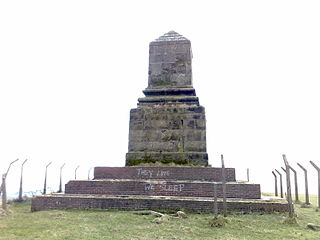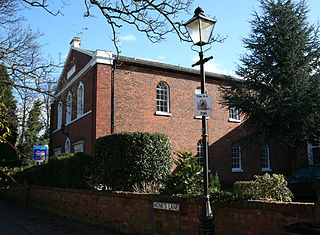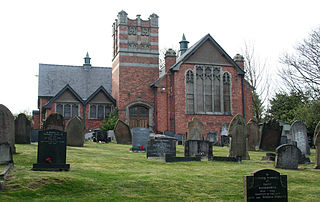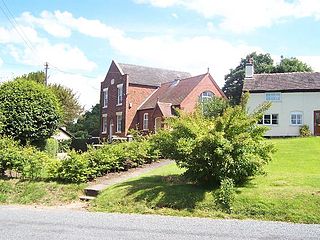Harriseahead is a village in the county of Staffordshire, England, just north of the Potteries and about 2 miles (3.2 km) south-west of Biddulph and close to the border with Cheshire. Population details from the 2011 census can be found under Kidsgrove.

Biddulph is a town in Staffordshire, England, 8.5 miles (14 km) north of Stoke-on-Trent and 4.5 miles (7 km) south-east of Congleton, Cheshire.
Audley Rural is a parish of Staffordshire, England, located four miles to the north-west of the town of Newcastle-under-Lyme. It is predominantly a rural area, of which Audley is the centre. Other settlements are Alsagers Bank, Bignall End, Halmer End, Miles Green, Scot Hay and Wood Lane, and the outlying hamlets of Dunkirk, Mill End, Shraley Brook, Eardley End, Coopers Green, Butters Green and Crackley Gates. The population of this parish at the 2011 census was 8,437.

Bignall Hill, Staffordshire is a local landmark, and forms part of an escarpment ridge 4 miles (6.4 km) north-west of Newcastle-under-Lyme. It is classed as a sub HuMP. There is a large stone monument on the summit which is dedicated to John Wedgwood (1760–1839), a former local employer and coal mine owner. Wedgwood's monument was initially an obelisk erected in 1850. Following storm damage in 1976 it was reduced to a quarter of its original size, although the base is still substantial. The monument is a Grade II listed building. The monument is today reachable by footpaths, and is the highest point in the area. It affords sweeping 360-degree views: south to Cannock Chase and the city of Stoke-on-Trent; north across the Cheshire Plains to Jodrell Bank radio telescope; east to Mow Cop Castle and the Peak District; and west to the mountains of North Wales and Snowdonia.

Hugh Bourne along with William Clowes was the joint founder of Primitive Methodism, the largest offshoot of Wesleyan Methodism and, in the mid-19th century, an influential Protestant Christian movement in its own right.

Mow Cop is a village split between Cheshire and Staffordshire, and therefore divided between the North West and West Midlands regions of England. It is 24 miles (39 km) south of Manchester and 6 miles (9.7 km) north of Stoke-on-Trent, on a steep hill of the same name rising to 335 metres (1,099 ft) above sea level. The village is at the edge of the southern Pennines, with the Cheshire Plain directly to the west. For population details taken at the 2011 census, see Kidsgrove. The Cheshire section is the highest settlement within the county of Cheshire.

The South Cheshire Way is a 34-mile (55 km) long-distance footpath running east–west mainly through Cheshire, England, although parts lie in Shropshire and Staffordshire. The western section from Grindley Brook, near Whitchurch, runs through farmland; the eastern section from Mow Cop, near Biddulph, runs through low hills. The footpath is waymarked with black-and-yellow discs inscribed 'SCW'. It is covered by the Ordnance Survey Explorer series 257 and 268 maps, which denote it with a green lozenge.

Odd Rode is a civil parish in the unitary authority of Cheshire East and the ceremonial county of Cheshire, England. It borders the Staffordshire parish of Kidsgrove. Of particular note in the area is Rode Hall, seat of the Wilbraham family.
The tiny hamlet of Ramsor in North Staffordshire played a significant part in the origins of Primitive Methodism. Listed in the Domesday Book as Ramshorn, this ancient hamlet is a typical example of the depopulation of the countryside. Very little now remains of this village apart from a few farms and cottages. The Primitive Methodist Chapel is the only surviving public building.

The Primitive Methodist Chapel is a former Primitive Methodist church on Welsh Row in Nantwich, Cheshire, England. Built in 1840, it is listed at grade II. The chapel closed in 2001, and the building has been partially converted to residential use.

The Congregational Chapel, also known as the Independent Chapel, is a former Congregational or Independent church in Nantwich, Cheshire, England. It is located on Monks Lane, now a pedestrian walkway, opposite the Dysart Buildings and immediately north east of St Mary's Church. Built in 1841–42, it is listed at grade II. The chapel closed in the late 20th century, and the building has been converted to residential use.

Scholar Green is a village in the civil parish of Odd Rode, in Cheshire, England. Encompassing the smaller settlements of Kent Green and The Bank, it is situated on the A34 near Mow Cop, Alsager, Rode Heath, Butt Lane and Kidsgrove and in the unitary authority area of Cheshire East.

Rode Hall, a Georgian country house, is the seat of the Wilbraham family, members of the landed gentry in the parish of Odd Rode, Cheshire, England. The estate, with the original timber-framed manor house, was purchased by the Wilbrahams from the ancient Rode family in 1669. The medieval manor house was replaced between 1700 and 1708 by a brick-built seven-bay building; a second building, with five bays, was built in 1752; the two buildings being joined in 1800 to form the present Rode Hall.

Brown Knowl Methodist Church is in Sherrington's Lane in the settlement of Brown Knowl in the civil parish of Broxton, Cheshire, England. The church, together with the former Sunday school, is recorded in the National Heritage List for England as a designated Grade II listed building.
Moreton cum Alcumlow is a civil parish in Cheshire East, England, United Kingdom. It contains 13 buildings that are recorded in the National Heritage List for England as designated listed buildings. Of these, one is listed at Grade II*, the middle grade, and the others are at Grade II. The major building in the parish is Great Moreton Hall; this and a number of structures associated with it are listed. The Macclesfield Canal runs through the parish, and four bridges crossing it are listed. Apart from the estate of Great Moreton Hall, the parish is rural, and two farmhouses are also listed.

All Saints Church is in the village of Scholar Green in the parish of Odd Rode, Cheshire, England. It is an Anglican parish church in the deanery of Congleton, the archdeaconry of Macclesfield, and the diocese of Chester. The church is recorded in the National Heritage List for England as a designated Grade II* listed building.
Odd Rode is a civil parish in Cheshire East, England. It contains 35 buildings that are recorded in the National Heritage List for England as designated listed buildings. Of these, one is listed at Grade I, the highest grade, five are listed at Grade II*, the middle grade, and the others are at Grade II. The most important listed building in the parish is Little Moreton Hall; other notable country houses include Rode Hall and Ramsdell Hall. Most of the other listed buildings are houses, farmhouses, and associated structures. The Macclesfield and the Trent and Mersey Canals run through the parish, and the listed buildings associated with these are bridges, milestones, and distance markers. The other listed buildings are a church. a folly, wellheads, and a public house.

Englesea Brook Chapel and Museum is in the village of Englesea-Brook, Cheshire, England. Built in 1828, the chapel was one of the earliest chapels of the Primitive Methodist movement, and the Sunday school was added in 1914. Since 1986 it has been a museum of Primitive Methodism. The building is recorded in the National Heritage List for England as a designated Grade II listed building. In the chapel is a historic pipe organ. The museum contains artefacts relating to the movement, and arranges a changing programme of exhibitions and other events. In the graveyard near the museum is a monument to Hugh Bourne, founder of the movement.
Kidsgrove is a civil parish in the district of Newcastle-under-Lyme, Staffordshire, England. The parish contains 29 listed buildings that are recorded in the National Heritage List for England. All the listed buildings are designated at Grade II, the lowest of the three grades, which is applied to "buildings of national importance and special interest". The parish contains the town of Kidsgrove, The villages of Talke and Newchapel, and part of the village of Mow Cop. The Trent and Mersey Canal passes through the parish, and the listed buildings associated with it are bridges, tunnel portals, and a milepost. Also listed are three tunnel portals built by the North Staffordshire Railway. The other listed buildings include a village cross with a medieval base, houses and cottages, farmhouses and farm buildings, churches, a vicarage, a chapel with a manse, a memorial in a churchyard, a folly, a tower, and a war memorial.














